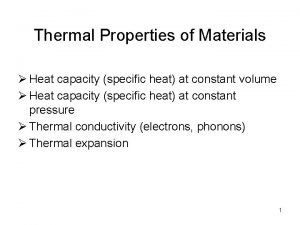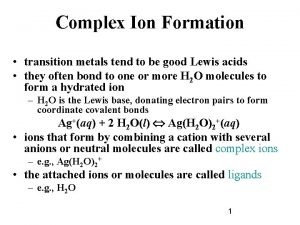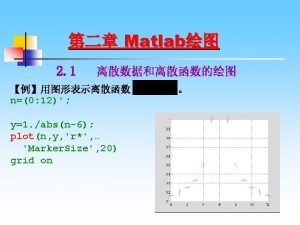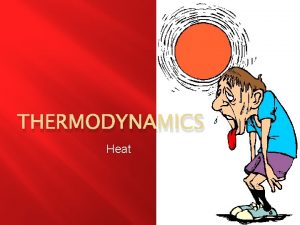Heat Flow Constant Volume hold fixed heat flows

![Constant Volume hold fixed heat flows at base to change temperature ] Fixing the Constant Volume hold fixed heat flows at base to change temperature ] Fixing the](https://slidetodoc.com/presentation_image_h2/c0a8cf8ffa7e1b3db6bcf0405d8acf60/image-2.jpg)
![Isochoric Process ] For a constant volume process there is no work. • • Isochoric Process ] For a constant volume process there is no work. • •](https://slidetodoc.com/presentation_image_h2/c0a8cf8ffa7e1b3db6bcf0405d8acf60/image-3.jpg)
![Specific Heat at Constant Volume ] At constant volume the heat equals the change Specific Heat at Constant Volume ] At constant volume the heat equals the change](https://slidetodoc.com/presentation_image_h2/c0a8cf8ffa7e1b3db6bcf0405d8acf60/image-4.jpg)
![Constant Pressure ] Allow the piston to move to keep the pressure constant. • Constant Pressure ] Allow the piston to move to keep the pressure constant. •](https://slidetodoc.com/presentation_image_h2/c0a8cf8ffa7e1b3db6bcf0405d8acf60/image-5.jpg)
![Isobaric Process ] For a constant pressure process the work is a simple product. Isobaric Process ] For a constant pressure process the work is a simple product.](https://slidetodoc.com/presentation_image_h2/c0a8cf8ffa7e1b3db6bcf0405d8acf60/image-6.jpg)
![Specific Heat at Constant Pressure ] The internal energy was related to the temperature Specific Heat at Constant Pressure ] The internal energy was related to the temperature](https://slidetodoc.com/presentation_image_h2/c0a8cf8ffa7e1b3db6bcf0405d8acf60/image-7.jpg)
![Specific Heat for Gases ] ] The ideal gas law predicts a Gas simple Specific Heat for Gases ] ] The ideal gas law predicts a Gas simple](https://slidetodoc.com/presentation_image_h2/c0a8cf8ffa7e1b3db6bcf0405d8acf60/image-8.jpg)
![No Heat ] ] completely insulate to block heat flow Completely insulate the system. No Heat ] ] completely insulate to block heat flow Completely insulate the system.](https://slidetodoc.com/presentation_image_h2/c0a8cf8ffa7e1b3db6bcf0405d8acf60/image-9.jpg)
![Adiabatic Process ] For an adiabatic process there is no heat flow. • ] Adiabatic Process ] For an adiabatic process there is no heat flow. • ]](https://slidetodoc.com/presentation_image_h2/c0a8cf8ffa7e1b3db6bcf0405d8acf60/image-10.jpg)
- Slides: 10

Heat Flow
![Constant Volume hold fixed heat flows at base to change temperature Fixing the Constant Volume hold fixed heat flows at base to change temperature ] Fixing the](https://slidetodoc.com/presentation_image_h2/c0a8cf8ffa7e1b3db6bcf0405d8acf60/image-2.jpg)
Constant Volume hold fixed heat flows at base to change temperature ] Fixing the piston keeps the volume constant. ] If heat flows in then temperature remains the same.
![Isochoric Process For a constant volume process there is no work Isochoric Process ] For a constant volume process there is no work. • •](https://slidetodoc.com/presentation_image_h2/c0a8cf8ffa7e1b3db6bcf0405d8acf60/image-3.jpg)
Isochoric Process ] For a constant volume process there is no work. • • ] DV = 0 W=0 P The internal energy change is only due to heat. • DU = Q – W = Q V isotherms
![Specific Heat at Constant Volume At constant volume the heat equals the change Specific Heat at Constant Volume ] At constant volume the heat equals the change](https://slidetodoc.com/presentation_image_h2/c0a8cf8ffa7e1b3db6bcf0405d8acf60/image-4.jpg)
Specific Heat at Constant Volume ] At constant volume the heat equals the change in internal energy. ] A molar specific heat at constant volume relates to the change in temperature. ] CV can be defined from the internal energy.
![Constant Pressure Allow the piston to move to keep the pressure constant Constant Pressure ] Allow the piston to move to keep the pressure constant. •](https://slidetodoc.com/presentation_image_h2/c0a8cf8ffa7e1b3db6bcf0405d8acf60/image-5.jpg)
Constant Pressure ] Allow the piston to move to keep the pressure constant. • Same on both sides ] move to maintain pressure heat flows at base to change temperature Heat flows in and the piston can do work.
![Isobaric Process For a constant pressure process the work is a simple product Isobaric Process ] For a constant pressure process the work is a simple product.](https://slidetodoc.com/presentation_image_h2/c0a8cf8ffa7e1b3db6bcf0405d8acf60/image-6.jpg)
Isobaric Process ] For a constant pressure process the work is a simple product. • ] P W = P (V 2 – V 1 ) The heat can be related to the internal energy change and volume change. • Q = DU + W • Q = DU + PDV V isotherms
![Specific Heat at Constant Pressure The internal energy was related to the temperature Specific Heat at Constant Pressure ] The internal energy was related to the temperature](https://slidetodoc.com/presentation_image_h2/c0a8cf8ffa7e1b3db6bcf0405d8acf60/image-7.jpg)
Specific Heat at Constant Pressure ] The internal energy was related to the temperature change. ] A molar specific heat at constant pressure relates to the change in temperature. ] For and ideal gas, CP can be defined from CV.
![Specific Heat for Gases The ideal gas law predicts a Gas simple Specific Heat for Gases ] ] The ideal gas law predicts a Gas simple](https://slidetodoc.com/presentation_image_h2/c0a8cf8ffa7e1b3db6bcf0405d8acf60/image-8.jpg)
Specific Heat for Gases ] ] The ideal gas law predicts a Gas simple relationship between He the two forms of specific heat. Ne • CP = CV + R N 2 • R = 1. 99 cal/mol-K O 2 CO 2 The table shows how close H 2 O real gases are to ideal gas C 2 H 6 behavior. CV 2. 98 4. 96 5. 03 6. 80 6. 20 10. 30 CP (cal/mol-K) 4. 97 6. 95 7. 03 8. 83 8. 20 12. 35
![No Heat completely insulate to block heat flow Completely insulate the system No Heat ] ] completely insulate to block heat flow Completely insulate the system.](https://slidetodoc.com/presentation_image_h2/c0a8cf8ffa7e1b3db6bcf0405d8acf60/image-9.jpg)
No Heat ] ] completely insulate to block heat flow Completely insulate the system. Allow the piston to move. ] Heat can’t flow, but work can be done. ] Equivalent process occurs when change is quick so little heat flows.
![Adiabatic Process For an adiabatic process there is no heat flow Adiabatic Process ] For an adiabatic process there is no heat flow. • ]](https://slidetodoc.com/presentation_image_h2/c0a8cf8ffa7e1b3db6bcf0405d8acf60/image-10.jpg)
Adiabatic Process ] For an adiabatic process there is no heat flow. • ] DU = Q – W = – W P There a relationship that can be derived for ideal gases. V isotherms
 How to find the specific heat capacity
How to find the specific heat capacity Slot machine schedule of reinforcement
Slot machine schedule of reinforcement Fixed interval vs fixed ratio
Fixed interval vs fixed ratio Variable interval
Variable interval Fixed order quantity
Fixed order quantity Fixed function ic
Fixed function ic Constant on-time control
Constant on-time control Constant pointer and pointer to constant
Constant pointer and pointer to constant What is pointer to pointer in c
What is pointer to pointer in c Constant pointer and pointer to constant
Constant pointer and pointer to constant Formation constant vs equilibrium constant
Formation constant vs equilibrium constant



















